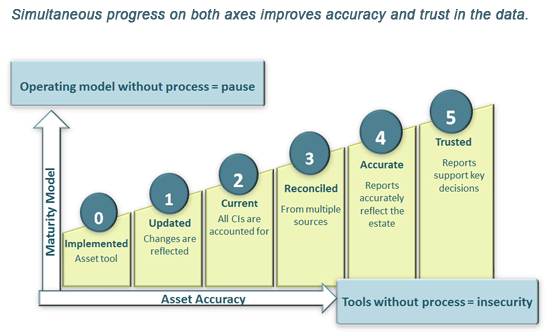Proper IT asset management (ITAM) is more than just good business; it results in hard dollar savings that drop to the bottom line. To conduct proper ITAM, an organization needs an enterprise-wide view of its asset estate, including identity, usage, spend and compliance. An IT asset maturity model can help organizations find and trust asset information. If you want to move forward, you need to understand where your organization fits on the IT asset maturity curve.
IT Maturity Asset Model

Here are the Top 5 benefits of climbing the IT asset maturity curve.
1. Pay only for the assets and services you use. Be sure that you are not only getting what you pay for but that you are not paying for what you are not getting. Without a good handle on your assets, you may end up managing too many assets or paying for “platinum” level support that you do not use outside business hours.
2. Build better negotiating power. Knowing what assets you have will allow you to build better contracts. Asset information has matured, too. How do you know you have the right asset counts? What is the cost of being wrong? Do you miss discounts or terms with the wrong asset information? Unanswered questions about assets can drive up costs.
3. Get right with operational compliance. Your environment is very complex; it takes multiple data sources to reconcile. Make sure you can answer these questions: Have all the back-ups been run? Are the assets up to date on virus protection?
4. Navigate risk and regulatory compliance. The financial loss exposure from these types of risks can include penalties for lost data as well as the cost of re-creating information. The proliferation of mobile devices and remote service points only increases this risk. Better asset management will provide cost savings from improved compliance and ensure assets are mapped to security parameters.
5. Enact ITAM process discipline. ITAM is closely linked to ITIL processes and enables improvements in four critical service management processes: change management, asset management, service performance and service level management, and IT governance. The discipline provided not only reduces the time spent in reconciling diverse reports; it also optimizes value by reducing unapproved changes, cycle time and downtime.
ISG enables firms to manage their IT estate through our Consumption Management (CM) offering. CM combines intelligent tools and disciplined processes that validate the existing information and reporting of configuration management database (CMDB), inventory, monitoring and operational tools. The benefits result in hard dollar savings. To discuss ITAM or CM further, contact us.
About the authorTerri is a trusted advisor with deep expertise in strategic asset management and IT global sourcing management. Terri brings a significant understanding of information technology strategy, processes and sourcing-related initiatives to ISG clients. Her roles include Managed Services Director for Technology Business Management (TBM Practice), Asset Management and Consumption Management (CM) within the ISG Managed Services practice, leading designs, solutions and implementations for IT financial and asset management solutions. Terri provides expertise in sourcing methodology, contract administration, financial, performance, relationship management, and transition management. Terri has published several articles on Asset Management, Sourcing Practices and IT Optimization.
